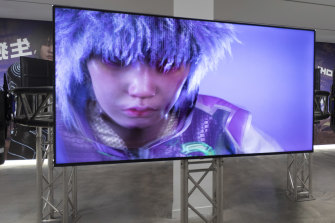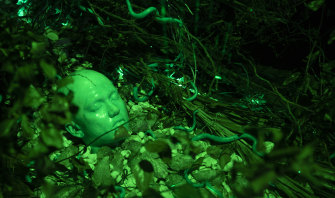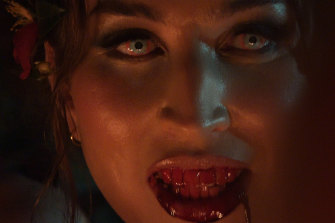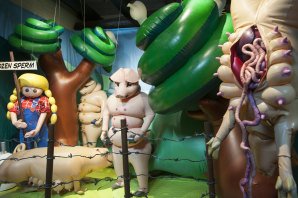Unreality bites: Searching for substance at the MCA’s new exhibition

Things have been quiet at the Museum of Contemporary Art this year, but Ultra Unreal aims at a reboot. It’s an exhibition that pushes beyond the contemporary, drawing us into virtual realms, both futuristic and animistic. These imaginary worlds have been created by new technology and populated with supernatural beings. It all sounds breathlessly exciting. Or does it?
I won’t attempt to improve on the MCA’s own summary of the show: “In Ultra Unreal, influences from religion, neuroscience, ecology, artificial intelligence, myth, gaming, and queer club cultures collide. Ricocheting between a dizzying array of stimuli, the fantastical worlds these artists create are also grounded in individual experience and politics. They are populated by hybrid creatures and genderfluid beings; places where gods and ghosts mingle with dreaming machines and ancient ceremonies merge with digital reincarnations.”
Chinese artist Lu Yang’s Animal (2021) on show at the MCA.Credit:Alex Davies
Whenever so many diverse themes are crammed into a single event (“a dizzying array of stimuli”), one can anticipate a good deal of confusion and superficiality. In this sense, Ultra Unreal lives up to expectations.
Curator Anna Davis has selected five artists or groups of artists, who will have you sitting for long periods watching ambiguous videos, absorbing an ever-changing succession of sights and sounds. It’s one of those shows for which the ideal audience might be recreational drug users – always in plentiful supply in Sydney. I’m not sure I could recommend it to curmudgeons who don’t play video games, don’t hang out in nightclubs, are pretty clear about their “belief systems”, and have no special interest in being “genderfluid”. For the amount of time viewers are required to invest in Ultra Unreal, I didn’t feel there was a commensurate return.
The featured artists are Club Ate (Sydney), Korakrit Arunanondchai and Alex Gvojic (Bangkok and New York), Lawrence Lek (London), Lu Yang (Shanghai) and Saeborg (Tokyo). Disappointingly, there is no catalogue for this show, so all information comes from the MCA website and an app that visitors are invited to download.
We’re told the show is “drawing inspiration from Ning Ken’s concept of the ultra-unreal”, but there’s not a word of explanation about Ning Ken, a Chinese novelist whose books are yet to be published in an English-language translation. The title of the exhibition comes from an essay by Ning, in which he coins the term chaohuan to describe the surreal nature of Chinese society in an era of rapid change.
Ning’s “ultra-unreal” has a lot in common with the magical realism we find in writers as diverse as Gabriel Garcia Marquez and Günter Grass, but he wants us to know that in China such things are daily occurrences. He cites stories of officials who stole so much cash that when their homes were raided it required trucks to remove the loot. Given the Chinese government’s sensitivity to anything that reflects badly on authority, one suspects that ultra-unreal literature may be a short-lived phenomenon.
The MCA must have thought the term sounded like a cool name for a show, because there are only the vaguest connections between Ning’s ideas and the art on display.
Chinese artist Lu Yang has worked with a team of designers and technicians to create avatars for his DOKU series. Lu appears as six different characters, loosely based on Buddhist cosmology. Each character – “asexual or without gender” – dances madly in a different fantasy environment. Regardless of the Buddhist associations, the works have the same aesthetic disposability as online games or music videos. They are produced with incredible skill, but there’s limited entertainment value in watching an artist dancing around in fancy dress.
Since 2012, Thai artist Korakrit Arunanondchai has been working on a project called Painting with History in a Room Filled with People with Funny Names. The work incorporates installation, performance, painting and sculpture, which we see in the form of a three-channel video, made in collaboration with American artist Alex Gvojic. If Lu Yang has too little substance, Arunanondchai gives us too much information.
Korakrit Arunanondchai and Alex Gvojic’s No History in a Room Filled with People with Funny Names 5 (2018).Credit:Alex Davies
This fifth iteration of his ongoing series is largely set in the town of Mae Sai, where the boys’ soccer team was trapped in an underwater cavern in 2018. There’s footage relating to this episode, and a performance in which another artist plays the role of the Naga, a supernatural being in the form of a snake.
Maybe I lacked patience, but this presentation reminded me that many acclaimed works of video art would never make the grade as cinema, lacking narrative thread, continuity, any pretence of drama, and so on. We’ve become too accustomed to the idea that a video may seem incomprehensible because it’s profound, rather than poorly realised or presented without adequate contextualisation.
Bhenji Ra and Justin Shoulder, the leading lights of Club Ate, make a more professional job of their excursions into Philippines folkore in Ang Idol Jo/You Are My Idol. Club Ate’s videos are cinematic vignettes, incorporating CGI, performance and a sensibility that might be described as Camp Gothic. They know how to tell a story, or at least a fragment of a story, and they know how to edit.
Club Ate’s (Bhenji Ra and Justin Shoulder) Ang Idol KO/You Are My Idol (2021-22).Credit:Alex Davies
In You Are My Idol, Ra appears as a supernatural being surfing on a crocodile against a sky streaked with lurid shades of red. In another scene, a feast is underway with a group of sexually ambiguous characters swapping tales around a crocodile-shaped mound of rice. Watching this queer-trans-shamanistic bacchanal, I began to doubt that anyone from Club Ate will ever be proposed for membership of the Australian Club.
Saeborg, from Japan, is represented by two installations which also feature as costumes for performances. Slaughterhouse and Pootopia began life in the Tokyo club scene and might be best appreciated by an audience of late-night fetishists or small children. Slaughterhouse is a farmyard, inhabited by inflatable animals; Pootopia, a playground for overgrown dung beetles who luxuriate among piles of plastic poo.
Saeborg’s latex-heavy Slaughterhouse (2015).Credit:Satoshi Takase
Perhaps one needs to live in a relentlessly urban environment such as Tokyo to get much fun out of plastic inflatable animals and poo. For me, it looked like a serious case of arrested development.
The final artist, Lawrence Lek, who was trained as an architect, creates convincing science fiction scenarios using gaming technology. His major piece, Geomancer, is a 48-minute film set in Singapore in 2065, the year of the nation’s centenary. A voice, very like those on your car navigation device, tells the story of an AI-powered satellite that plunges to earth with the intention of becoming an artist.
It’s an idea that goes against the conventional belief that the logical mind of the computer is immune to the attractions of art. Lek teases out the thought that as AI evolves, the machines will develop an artistic urge, and perhaps do it better than us. His geomancer wants to be an individual, craving experiences, such as gambling, that cannot be entirely controlled by a super-intelligence.
Lek was the only artist in the show whose work seemed genuinely thought-provoking. There may be an abundance of “ideas” in Ultra Unreal, but most of them are too scattered to be anything more than a few minutes of distraction. Lek not only raised ideas, he explored and extended them, making it clear that imaginary worlds can be virtual without being ephemeral.
If viewers really want to see something mind-blowing this week, I’d refer them instead to Indigenous artist John Prince Siddon’s show, My Painting is My Voice, at Arthouse Gallery. A former stockman living in remote Fitzroy Crossing, Siddon’s paintings combine commentary on global events with his own traditional stories and motifs. It’s a forceful demonstration that hi-tech and plastic are completely unnecessary when you have an imagination that knows no boundaries.
Ultra Unreal runs at the Museum of Contemporary Art until October 2. John Prince Siddon’s My Painting is My Voice is at Arthouse Gallery until August 13.
To read more from Spectrum, visit our page here.
Most Viewed in Culture
From our partners
Source: Read Full Article



